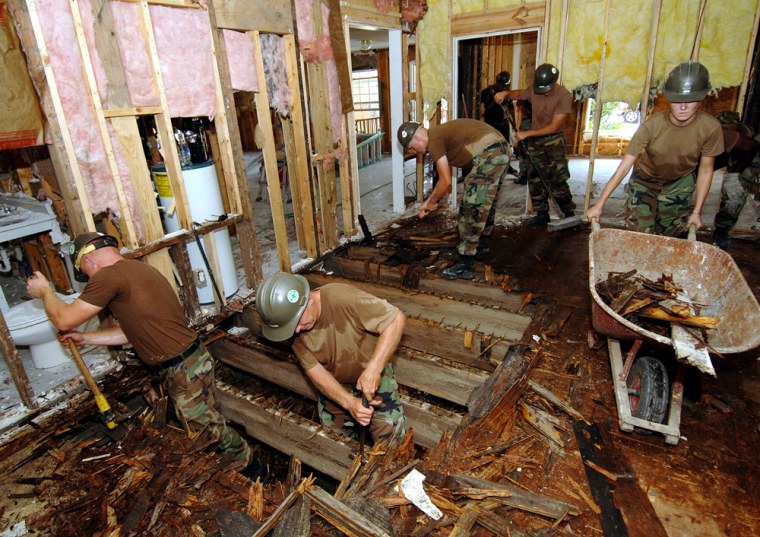Once the local television station announced that hurricane money was finally coming to Stone County, word spread fast.
People began showing up in front of Stone High School just after 10 p.m. Monday. By 8 the next morning, when the Red Cross opened for business, the line was 4 1/2 blocks long.
This line was just to get a number for an appointment later in the week that could land a cash voucher. "We've been waiting 15 days, so I guess we can wait some more," said Waymon Parker, whose trailer was wrecked.
As relief agencies are starting to get around to the last coastal towns left on their lists, assessments of Hurricane Katrina's devastation to 80 miles of coast and reaching 150 miles inland are just getting underway. State officials could offer no figures for damage to the Gulf Coast, but they say that Mississippi will take years, if not decades, to rebuild.
More than 115,000 evacuees remain in Red Cross shelters or temporary housing, and tens of thousands of others are staying with relatives or in other temporary housing. Debris is virtually all that is left of some smaller coastal towns. The Federal Emergency Management Agency remains swamped with cries for help. The agency has identified more than 154,000 people in need of assistance so far, said a spokesman, Gene Romano. It anticipates perhaps hundreds of thousands more as hurricane victims who have been trying to reach FEMA finally get through.
At the same time, life has noticeably improved in the five coastal counties where Katrina unleashed the brunt of her fury -- Stone, Hancock, Harrison, Jackson and Pearl River, where about 435,000 people lived and the death toll has reached 218, with 600 people reported missing. More businesses open every day, power is back to 80 percent of the buildings that could receive power and lines for gasoline are back to normal.
The Gulf Coast has a future; on that, most agree. But whether it can re-create a culture that took more than 200 years to build, return with its blend of residents, black and white, rich and poor, old money and new immigrant, or become an entirely new and unfamiliar version of itself -- that is another story.
Even as the immediate mop-up of Katrina has brought in thousands of National Guard crews and relief workers from all over the country, some in once-booming Mississippi coast towns are worrying about what will come afterward.
‘We've lost our history’
Mayor A.J. Holloway of Biloxi (population 55,000) is among them. Biloxi, home to 10 casinos and most of the Mississippi coast's shrimp industry, was devastated from its waterfront to well inland, with more than 5,000 structures destroyed and uncounted others too damaged to fix.
"We've lost our history, all of our landmarks," Holloway said. "We have some completely devastated areas, especially along the east end." Those included the city's old, working-class and poor neighborhoods, which casinos had coveted for years as prime real estate.
The Gulf Coast was the heart of Mississippi's floating casino industry, accounting for nearly half of the state's nearly $2.93 billion a year in gambling revenue. With the coast's 13 casinos destroyed by the hurricane, Mississippi, already the poorest state in the nation, is losing $500,000 in gambling taxes every day. Now the casino industry is lobbying for land-based alternatives to their former barges, and some fear the coast will look like a cut-rate Las Vegas, with slablike condominiums, cinder-block subdivisions, gaudy hotels.
The $700 million-a-year shrimping industry lost not only much of its fleet but also the processing plants needed to bring the shellfish to market, at the peak of the season.
The immediate cleanup of Katrina is just beginning. Garbage trucks have just started to roll through towns in the last few days, and schools are gearing up to open, in some places as early as next Monday, in others by the beginning of next month. Officials on the Gulf Coast are also trying to find a way to ease traffic, now that it appears that Interstate 90, the major coastal highway, will not reopen for at least 90 days.
"If I'd said on August 29th that two weeks later we were going to be where we are now -- well, no one would believe me," said Col. Joe Spraggins, the relentlessly upbeat director of emergency operations for Harrison County (population 185,000). "I mean, we're doing great," he said. "I could see now that the future of the coast will be better than ever."
Others are not so sure. "We've lost 80 percent of Hancock County, at least," said Eddie Favre, the mayor of Bay St. Louis, which had 8,000 residents.
Its neighbor, Waveland, which had 7,000 residents, lost virtually its entire infrastructure and population. Only about two dozen residents remain, living off relief food and water.
Jewel of the coast
Pass Christian, a city of about 8,500, was considered the little jewel of the coast, a place where tourists came just to gawk at its mix of antebellum mansions and century-old shotgun shacks. Almost the entire city is gone, save for between 50 to 100 houses on the east side, where residents have been holed up since the hurricane, said Joseph Piernas, an alderman there.
Those who lost their houses or businesses were finally allowed into Pass Christian to survey the damage Tuesday morning, though lines hours long have tried to get into the town every day for a week, only to be turned away by the National Guard.
"The good news is, people are saying they'll rebuild," Piernas said. "We have no idea when that can start."
The governor's office said 1,250 FEMA trailers or mobile homes were in a staging area in Jackson, 135 were ready for occupancy and 20 have been delivered to evacuees in Biloxi, where perhaps as many as 20,000 people need new places to live.
